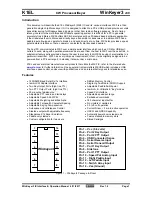
www.hamgadgets.com
2014-01-17
ID-O-Matic III
12
drops, then ID after a few seconds of inactivity. This is often desirable if, for example, you are
using CTCSS to reduce the likelihood that users will hear the Morse code ID. Idle time sets the
number of seconds that the repeater must be idle before an ID will occur. If you don’t want to
use this feature, simply leave the idle time set to zero.
The ID minimum and idle time settings are used to try to provide a “polite” ID that occurs when
no one is actively using the repeater. As always, the ID interval setting takes precedence; an ID
will always be sent if the normal ID timer (ID interval setting) expires even if attempts at a polite
ID don’t work due to heavy or constant repeater use.
First ID
: After the repeater has been idle for longer than the normal ID interval, it will attempt
to ID immediately after the first time it’s keyed up by a user. The First ID setting determines the
minimum delay before this initial ID is sent. This will be a “polite” ID, meaning the ID will be
sent after the user un-keys – or, if COR is active long enough, at the time-out time or the normal
ID interval. If you set this timer to zero the short first ID interval feature will be disabled, and
the normal ID time (with minimum/early ID time, if set) will be used.
Beacon interval
: You may want your repeater to ID even when it’s not been used for a while.
You can set this timer to ID the repeater as often as you wish, in seconds. For example, 3600
will send an ID every hour whenever the repeater is idle. If you do not wish to have beacon ID
messages sent, just set this to zero to disable beacons.
Random beacons
: Set to Y or N. If this is set to Y, the beacons will be sent at semi-random
times up to but not exceeding the beacon interval. This would normally be used for a “fox hunt”
transmitter.
Time sync BCN:
This selection will only appear if the real-time clock is set. If this is set to Y,
the beacon transmissions will occur at appropriate clock times. For example, a one hour beacon
(3600) will be sent on the hour. A 30 minute (1800) beacon would be sent on the hour and at 30
minutes past; a 15 minute beacon (900) would be sent on the hour and at 15, 30 and 45 minutes
after the hour and so on.
PTT watchdog
: The maximum time, in seconds, that PTT is allowed to be active before the
repeater stops transmitting. If you do not wish to have a PTT timeout, set this to zero.
PTT hang time
: The amount of time the PTT line will stay active after COR drops. The hang
timer starts after the courtesy beep and/or ID message have been sent. Enter the time desired in
1/10 second increments – so for half a second enter 5, or for one second enter 10 and so on.
ID delay time
: You may wish to key the transmitter for a brief period before sending the ID
message – for example, to allow link transmitters to key up. Enter the time desired in 1/10
second increments – so for one second, enter “10”.
Fan timer
: If you are using the ID-O-Matic III to control a cooling fan, this is the amount of
time in seconds that the fan will run after the PTT line drops. The fan timer is reset with each
transmission.
Summary of Contents for ID-O-Matic III
Page 1: ...www hamgadgets com 2014 01 17 HamGadgets ID O Matic III Assembly Setup and Use Guide ...
Page 26: ...www hamgadgets com 2014 01 17 ID O Matic III 26 PCB Layout Schematic Rev C ...
Page 27: ...www hamgadgets com 2014 01 17 ID O Matic III 27 PCB Layout Schematic Rev D ...
Page 32: ...www hamgadgets com 2014 01 17 ID O Matic III 32 ...













































